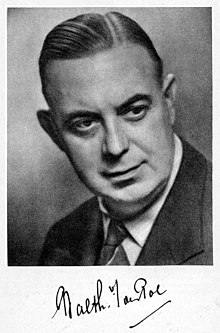Balthasar van der Pol (27 January 1889 – 6 October 1959) was a Dutch physicist.
Balthasar van der Pol
| |
|---|---|

Prof. Dr. B. van der Pol, 1939
| |
| Born | (1889-01-27)27 January 1889
Utrecht, Netherlands
|
| Died | 6 October 1959(1959-10-06) (aged 70)
Wassenaar, Netherlands
|
| Nationality | Dutch |
| Alma mater | Utrecht University |
| Known for | Van der Pol oscillator |
| Awards |
|
| Scientific career | |
| Fields | Physics |
| Thesis | (1920) |
| Doctoral advisor | Willem Henri Julius |
Van der Pol began his studies of physics in Utrecht in 1911. J. A. Fleming offered van der Pol the use of the Pender Electrical Laboratory at University College for a study of the heuristics of wireless reception on board ships.[1]InEngland he also worked with J. J. Thomson. Upon his return to the Netherlands, Balthsar worked with Hendrik LorentzatTeylers Stichting. For his thesis he wrote The effect of an ionised gas on electro-magnetic wave propagation and its application to radio, as demonstrated by glow-discharge measurement[2] under the supervision of Willem Henri Julius. He was awarded his Ph.D. in 1920. He joined Philips Research Laboratories in 1921, where he worked until his retirement in 1949.
As observed by Hendrik Casimir, "Radio might have remained a field of haphazard empiricism along with wild commercial ventures, but for the influence of men like Van der Pol who stressed the need for a more scientific approach."[3]
The differential equations of coupled electrical systems drew his interest, and he developed the idea of "relaxation oscillations".[4][5] With J. van der Mark he applied the idea to the heartbeat,[6] which provided one of the earliest quantitative models of the action potential. These studies led him to the van der Pol equation and Oliver Heaviside’s operational calculus for dealing with differential equations. He submitted articles to Philosophical Magazine on the operational calculus and, in coordination with H. Bremmer, wrote Modern Operational Calculus based on the Two-sided Laplace Integral, published by Cambridge University Press.
He was awarded the Institute of Radio Engineers (now the IEEE) Medal of Honor in 1935. The asteroid 10443 van der Pol was named after him.
Van der Pol became member of the Royal Netherlands Academy of Arts and Sciences in 1949.[7]